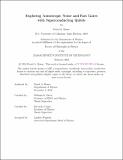Exploring Anisotropic Noise and Fast Gates with Superconducting Qubits
Author(s)
Rower, David A.
DownloadThesis PDF (26.32Mb)
Advisor
Oliver, William D.
Comin, Riccardo
Terms of use
Metadata
Show full item recordAbstract
Rapid recent progress in the engineering of quantum systems across multiple platforms has enabled quantum science at never-before-seen precision and scale, and may yield useful quantum technology. However, two major challenges slow such progress: (1) decoherence from interactions between target systems and uncontrolled external degrees of freedom, and (2) errors in the control of target systems, which often arise from physics beyond the models used to design control protocols. We report on three novel results addressing both coherence and control, utilizing superconducting qubits.
Our first result is the characterization of superconducting qubit flux noise, a primary source of decoherence, under the influence of weak, in-plane magnetic fields. We reveal two trends which serve as a novel experimental benchmark for microscopic theories of flux noise: (1) a 1/f to approximately Lorentzian transition in the noise power spectral density below 1 Hz, and (2) noise suppression above 1 MHz.
Our second result is the suppression of coherent qubit-control errors induced by the counter-rotating component of strong, linearly-polarized drives. We establish two complementary protocols for mitigating such errors, which previously limited the speed of single-qubit gates for low-frequency qubits. The first protocol realizes circularly-polarized drives in circuit quantum electrodynamics. The second protocol---commensurate pulses---uses pulse-timing restrictions to homogenize counter-rotating errors and enable their mitigation with conventional calibration routines. With commensurate pulses, we demonstrate world-class single-qubit gate fidelities reliably exceeding 99.997%.
Our third result is the observation of a novel signature in the decoherence dynamics of qubits subject to anisotropic transverse noise. Through injected noise experiments with a fluxonium qubit, we directly observe time-domain state-purity oscillations at twice the qubit frequency arising from the intrinsic qubit Larmor precession. We probe the oscillation dependence on noise anisotropy, lab-frame orientation, and power spectral density. Such oscillations are a result of physics beyond standard qubit-decoherence models within the rotating-wave approximation, and were previously unobserved in experiment.
Date issued
2025-02Department
Massachusetts Institute of Technology. Department of PhysicsPublisher
Massachusetts Institute of Technology